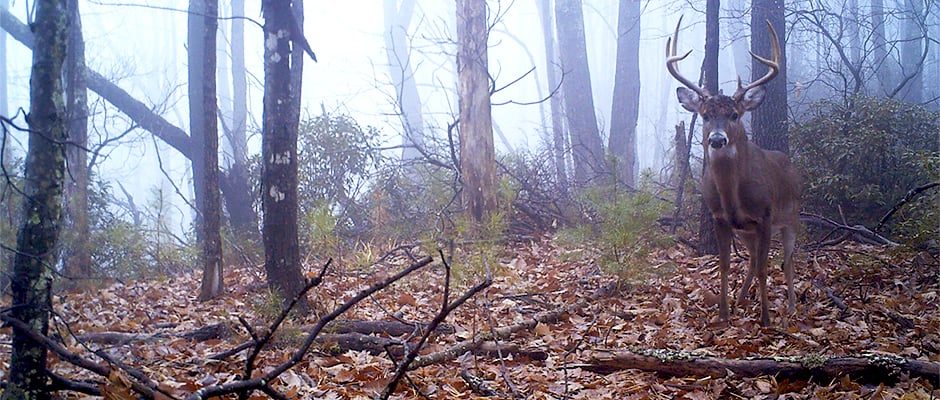Share this article
Wild Cam: Wildlife largely undisturbed by outdoor adventurers
Have you ever wondered whether your hike through the woods is disturbing wildlife? You can probably relax, according to a new study that assessed how animals react to hunting and hiking across the eastern United States.
As part of the study, citizen scientists deployed 1,947 camera traps in 32 protected areas such as state parks and nature preserves, and pored through more than 53,000 pictures of wildlife. Animals showed only minor behavior changes in areas with hunting, and they appeared perfectly willing to share trails and habitats with hikers.
“The most important findings are that recreation and wildlife can coexist in our natural protected areas,” said TWS member Roland Kays, a wildlife biologist with the North Carolina Museum of Natural Sciences and North Carolina State University and lead author of the study recently published in the Journal of Applied Ecology. (Watch Kays speak about citizen scientist camera trapping during an Ignite TWS event.)
In a new addition to our Wild Cam series, we highlight some of the camera trap images from the study and explain what the data revealed.

Citizen scientists set camera traps in groups of three: one on a trail; one about 55 yards from the trail; and one about 220 yards away. Using the camera trap images, the researchers compared how animals behaved at different distances from trails, as well as around trails with heavy and low human traffic. To assess the effects of hunting, they compared areas with legal hunting to those where hunting was banned.
For most species, outdoor recreation had little impact on animals’ choice of habitats. The most important factors affecting animal sightings were the size of forest patches and the number of houses in the vicinity. Some species actually preferred fragmented forests, but bobcats (Lynx rufus) and American black bears (Ursus americanus) were found more often in large, unbroken wild areas. These bear cubs were photographed by a camera trap near Front Royal, Va.

Of the 12 species the researchers analyzed, bobcats showed the strongest preference for large wild areas and few houses. They also avoided heavily used trails, especially in areas with hunting.

©Anna Miller
The four most-hunted species — white-tailed deer (Odocoileus virginianus), eastern gray squirrel (Sciurus carolinensis), eastern fox squirrel (Sciurus niger) and northern raccoon (Procyon lotor) — all showed a preference for areas without hunting. Nevertheless, all were common throughout the study region. Here, a buck stands in the mist in Stone Mountain State Park, N.C.
“The whole reason a lot of these parks allow hunting is because they have too many deer. And so they actually would like to find ways that human hunting could have more of an impact on the deer population,” Kays said.

Coyotes (Canis latrans) responded more strongly to human recreation than any other species. Surprisingly, they actually seemed to be drawn to human activity, appearing often on hiking trails and in hunted areas. Here, a coyote pads along a trail in Shenandoah National Park, Va.
The researchers aren’t sure why they got more pictures of coyotes in hunted areas, but they suspect it may have to do with social upheaval that coyotes experience when humans kill members of a pack.
“It’s sort of like you remove one territorial animal, and you get replaced by three or four young ones trying to fight over the slot,” said Kays.
Coyotes weren’t the only animals to be drawn to hiking trails. This video compilation of camera trap photos shows diverse species on a stretch of trail in Shenandoah National Park that also sees high human traffic. Red foxes and gray squirrels actually seemed to prefer busy trails.

Sometimes the cameras caught rare sightings, such as this fisher (Martes pennant) in Maryland. Fishers are expanding into new areas, and this picture was the first documented sighting of the species in the county, according to Kays.

All of the protected areas in the study allowed hiking, so it’s possible that animal behavior is different in areas with no recreation at all. Still, the results are encouraging. Across six states, animals consistently showed that they can share natural areas with human outdoor enthusiasts, suggesting that current management practices are working, says Kays.
“Kudos to the park managers who are already doing this balancing act for management between biodiversity conservation, and recreation,” Kays said. “I think this is a credit to them.”
Header Image: ©Anna Miller








